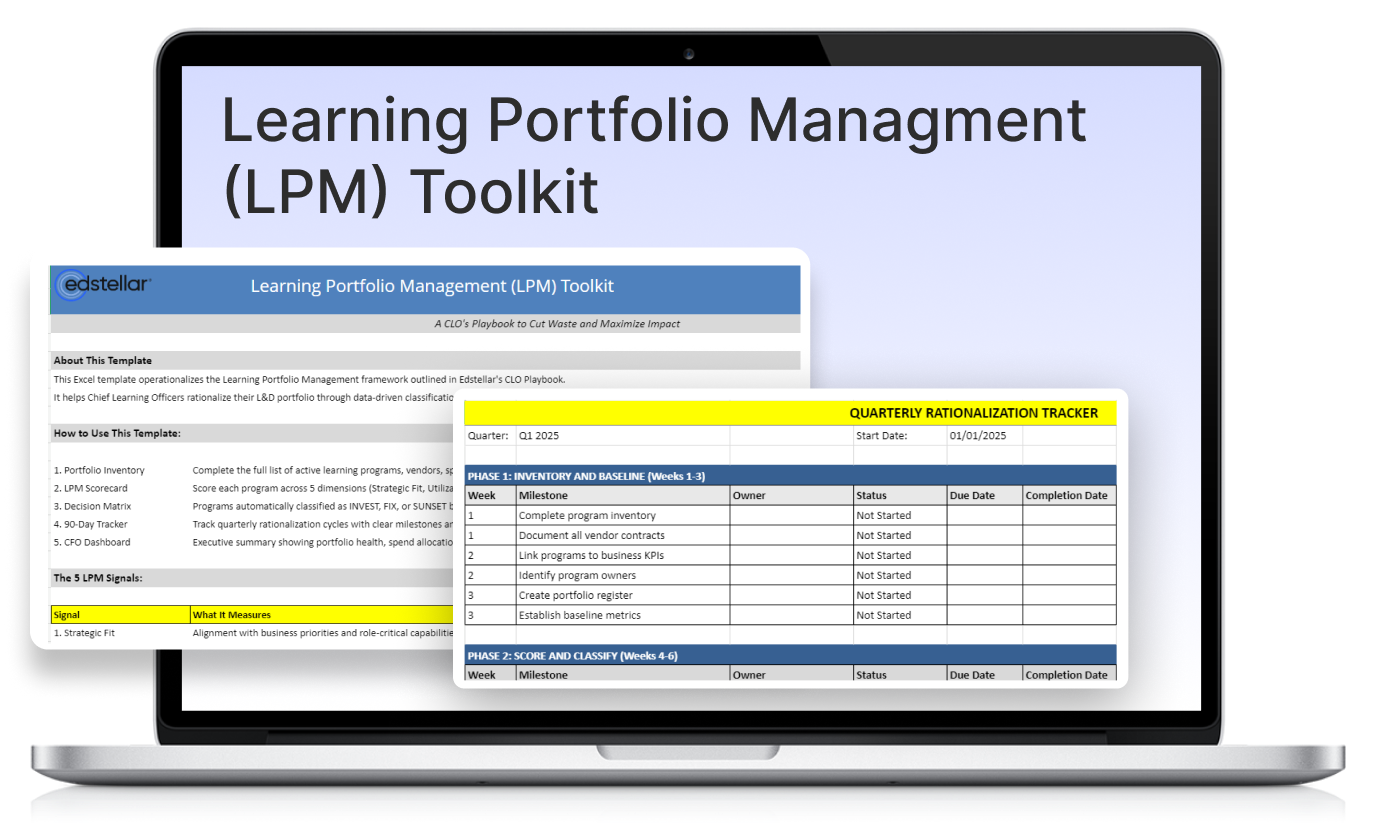The Learning Portfolio Management (LPM) Toolkit Template helps CLOs manage learning with fiscal discipline and strategic clarity. It evaluates every program using key signals, strategic alignment, utilization, cost per outcome, business impact, and scalability, to identify which to invest in, fix, or sunset. The toolkit combines the Portfolio Rationalization Scorecard, a 90-day operating rhythm, and governance guardrails to turn learning portfolios into systems of continuous optimization. By replacing guesswork with data, it enables CLOs to reallocate spend toward measurable capability growth, eliminate redundancy, and prove that every learning investment drives business performance and enterprise value.
What’s Inside the Learning Portfolio Management (LPM) Toolkit Template?
The LPM Toolkit Template equips CLOs with a structured, data-driven system to evaluate and optimize learning portfolios. It includes a program inventory, scoring matrix, decision dashboard, impact tracker, and quarterly review sheet, enabling clear visibility, evidence-based decision-making, and continuous reinvestment in high-impact learning programs.
Key Components Included
- Program Inventory Sheet: A master list capturing all learning programs, ownership, spend, target audience, and intended business outcomes. This forms your single source of truth.
- LPM Scorecard Matrix: The heart of the toolkit, where each program is rated across five weighted dimensions: Strategic Fit, Utilization & Reach, Cost per Outcome, Business Impact Evidence, and Delivery Risk & Scalability.
- Decision Dashboard: An automated summary that categorizes each program as Invest, Fix, or Sunset, providing a clear visual snapshot of portfolio health.
- Impact Tracker: A section for recording measurable results such as cost savings, performance improvements, or hours redeployed, enabling ROI visibility over time.
- Quarterly Review Template: A ready-to-use reporting sheet to support executive reviews, showing spend vs. impact, key portfolio shifts, and next-quarter reinvestment areas.
Learning Portfolio Management (LPM) Toolkit Template: Features
- Data-Driven Program Evaluation: Evaluates each learning program across key signals, strategic alignment, utilization, cost per outcome, business impact, and scalability to ensure every dollar drives measurable value.
- Portfolio Rationalization Scorecard: Converts analysis into clear investment decisions using weighted scoring and classification into Invest, Fix, or Sunset categories.
- 90-Day Operating Rhythm: Provides a structured quarterly process for inventory, scoring, reallocation, and executive review, turning portfolio optimization into a repeatable business discipline.
- Governance and ROI Visibility: Offers built-in dashboards and review templates that help CLOs track performance, demonstrate fiscal accountability, and link learning spend to enterprise outcomes.
Who Should Use the Learning Portfolio Management (LPM) Toolkit Template?
How to Use the Learning Portfolio Management (LPM) Toolkit Template
Open Portfolio Inventory and list every active program. Complete owner, audience, modality, annual enrollments, annual spend, cost per learner, vendor, and the business KPI linked. This becomes your single source of truth.
Go to LPM Scorecard. For each Program ID, enter 1–10 scores for the five signals: Strategic Fit, Utilization & Reach, Cost per Outcome, Business Impact Evidence, and Scalability. The sheet applies pre-set weights and calculates a Weighted Score and classification.
Open Decision Matrix. Programs are automatically grouped into INVEST, FIX, and SUNSET with current spend, enrollment, and a “next quarter action” column. Add sponsor names and confirm actions.
Use 90-Day Tracker to run the cadence: Weeks 1–3 inventory, Weeks 4–6 scoring, Weeks 7–9 reallocate/redesign, Weeks 10–12 executive review. Assign owners, due dates, notes, and mark blockers.
Update the CFO Dashboard to auto-summarize portfolio health: total programs, active learners, total spend, average spend per learner, cost per outcome, and learning hours per employee. Use this in QBRs.
Reference Benchmarks to ground your ratios and efficiency metrics when socializing results with Finance and BU leaders.
Re-score new and changed programs, sunset low-value items, and redirect budget per the Decision Matrix. The dashboard and tracker become your running governance system.
Benefits of Using a Learning Portfolio Management (LPM) Toolkit Template
For Organizations
Optimized Learning Investments
Enables data-driven decisions to ensure every training dollar delivers measurable business value.
Reduced Redundancy and Waste
Identifies overlapping programs, duplicate vendors, and underperforming initiatives to streamline spending.
Improved Strategic Alignment
Aligns learning initiatives directly with enterprise goals, ensuring clear linkage between learning and business outcomes.
Enhanced Reporting and Governance
Provides a standardized framework and dashboards for transparent reporting to executives and financial stakeholders.
For CLOs and L&D Leaders
Clear Decision-Making Framework
Replaces guesswork with evidence-based criteria to classify programs as Invest, Fix, or Sunset.
Quarterly Governance Rhythm
Establishes a 90-day cadence that keeps the portfolio current, accountable, and strategically aligned.
CFO-Ready ROI Insights
Translates learning metrics into financial language, cost per outcome, utilization, and impact, building executive trust.
Time and Resource Efficiency
Reduces administrative complexity, helping CLOs focus on capability growth instead of chasing fragmented program data.
